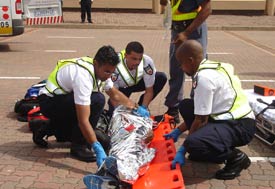Injuries cause 5 million global deaths each year
January / February 2015 | Volume 14, Issue 1
Opinion by Fogarty Director Dr Roger I Glass
At Fogarty, we pride ourselves on determining the gaps in global health research. One such neglected area is trauma and injury research and training.
Every six seconds someone in the world dies as a result of an injury, which adds up to a staggering toll of more than 5 million deaths each year, the WHO reports. That accounts for about 9 percent of global deaths, or nearly 1.7 times the number of fatalities resulting from HIV/AIDS, tuberculosis and malaria combined. Tens of millions more suffer injuries that require treatment and often cause temporary or permanent disabilities.
For the past decade, we've been supporting critical projects that strengthen the capacity of low- and middle-income country (LMIC) institutions to study ways to prevent or respond to road traffic injuries, drowning, agricultural injuries, burns, falls, poisonings, domestic violence and self-harm.

Photo courtesy of WHO/Margie Peden
Fogarty supports research to strengthen the
capacity of low- and middle-income country
institutions to study ways to prevent or respond to
trauma and injury.
But with such an enormous global burden of trauma and injury, it is imperative that we redouble our efforts to develop expertise and support research where it's needed most. About 90 percent of injury-related deaths occur in LMICs, according to the WHO, with higher rates among poorer citizens who are least able to pay for treatment and suffer most from income loss during their recovery. The poor are at higher risk for injuries because they are faced with hazardous situations on a daily basis. For example, pedestrians on unsafe, overcrowded and badly maintained roads are at greater risk of being hit by cars, buses or other vehicles. People living in poorly constructed homes without safety devices are more susceptible to burns and falls. In addition, many LMICs have inadequate health care and lack infrastructure such as paved roads and emergency response systems.
Despite growing awareness of the scale of the problem, there is little action being taken by policymakers. Since there are proven strategies to reduce trauma and injury, it is essential that we train and support local researchers to study how interventions can best be implemented to suit the local culture and circumstances. That's one of the key aims of the Fogarty International Collaborative Trauma and Injury Research Training Program.
As we consider how to advance the field, we have been reviewing our grantees' accomplishments to date. We've also been examining the landscape to see what needs remain unmet and which research questions are unanswered.
It's encouraging to see the tremendous returns we have received from a relatively modest investment. For example, with 10 years of support to Johns Hopkins University, a cadre of about a dozen faculty and researchers has been trained in trauma and injury in Pakistan. With this expertise, they have spearheaded projects to create software for emergency care data collection at hospitals, methodology to accurately assess trauma and emergency care capacity, and a surveillance system to measure traffic injuries - the largest contributor to this health burden. Meanwhile, a grant to the University of Maryland has supported trauma training throughout the Arab Middle East, providing intensive summer courses and the opportunity for mentored research projects. More than 450 trainees have participated from Egypt, Iraq, Sudan, Libya, the West Bank and Afghanistan, with many going on to leadership positions in national health ministries or health care systems.
In China, a project has supported training for more than 80 mid-level and senior researchers who have studied various risk factors for agricultural injuries related to alcohol consumption, sleep patterns, pesticide exposure and others. The need is great - a recent study of farmers in rural China showed more than 590,000 injury deaths occur annually and about 3.5 million workers are permanently disabled. Clearly, there is much work to be done.
We are grateful to our partners for their continued support in this important work, including the CDC's National Center for Injury Prevention and Control, the WHO, and the NIH Office of Research on Women's Health (ORWH), Office of Behavioral and Social Sciences Research (OBSSR), National Institute on Alcohol Abuse and Alcoholism (NIAAA), and National Institute of Neurological Disorders and Stroke (NINDS).
More Information
To view Adobe PDF files,
download current, free accessible plug-ins from Adobe's website.